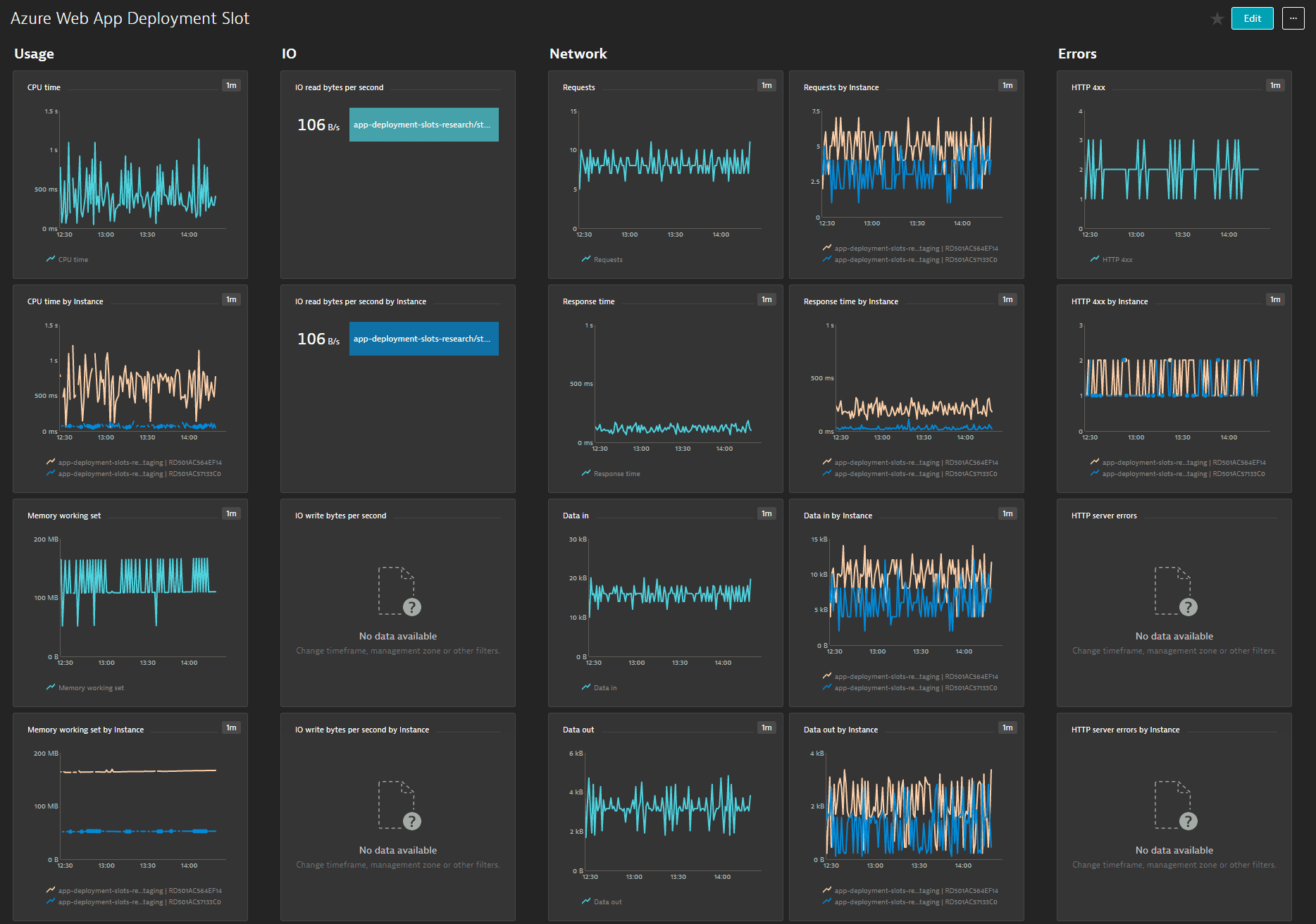Enable Deployment Slot metrics
Dynatrace ingests metrics from Azure Metrics API for Azure App Service (App Service Plan, Web App Deployment Slot). You can view metrics for each service instance, split metrics into multiple dimensions, and create custom charts that you can pin to your dashboards.
Prerequisites
- Dynatrace version 1.203+
- Environment ActiveGate version 1.195+
Enable monitoring
To learn how to enable service monitoring, see Enable service monitoring.
View service metrics
You can view the service metrics in your Dynatrace environment either on the custom device overview page or on your Dashboards page.
View metrics on the custom device overview page
To access the custom device overview page
- Go to Technologies & Processes or Technologies & Processes Classic (latest Dynatrace).
Filter by service name and select the relevant custom device group.
- Once you select the custom device group, you're on the custom device group overview page.
- The custom device group overview page lists all instances (custom devices) belonging to the group. Select an instance to view the custom device overview page.
View metrics on your dashboard
Once you add a service to monitoring, a preset dashboard for the respective service containing all recommended metrics is automatically created on your Dashboards page. You can look for specific dashboards by filtering by Preset and then by Name.
For existing monitored services, you might need to resave your credentials for the preset dashboard to appear on the Dashboards page. To resave your credentials, go to Settings > Cloud and virtualization > Azure, select the desired Azure instance, then select Save.
You can't make changes on a preset dashboard directly, but you can clone and edit it. To clone a dashboard, open the browse menu (…) and select Clone.
To remove a dashboard from the dashboards list, you can hide it. To hide a dashboard, open the browse menu (…) and select Hide.
Hiding a dashboard doesn't affect other users.


Available metrics
| Name | Description | Dimensions | Unit | Recommended |
|---|---|---|---|---|
| CpuTime | CPU time | Instance | Second | |
| Requests | Number of requests | Instance | Count | |
| BytesReceived | Bytes received | Instance | Byte | |
| BytesSent | Bytes sent | Instance | Byte | |
| Http101 | HTTP 101 server error | Instance | Count | |
| Http2xx | HTTP 2xx server error | Instance | Count | |
| Http3xx | HTTP 3xx server error | Instance | Count | |
| Http401 | HTTP 401 server error | Instance | Count | |
| Http403 | HTTP 403 server error | Instance | Count | |
| Http404 | HTTP 404 server error | Instance | Count | |
| Http406 | HTTP 406 server error | Instance | Count | |
| Http4xx | HTTP 4xx server error | Instance | Count | |
| Http5xx | HTTP 5xx server error | Instance | Count | |
| MemoryWorkingSet | Memory working set | Instance | Byte | |
| AverageMemoryWorkingSet | Average memory working set | Instance | Byte | |
| AverageResponseTime | Average response time | Instance | Second | |
| HttpResponseTime | HTTP response time | Instance | Second | |
| AppConnections | Number of App connections | Instance | Count | |
| Handles | Number of handles | Instance | Count | |
| Threads | Number of threads | Instance | Count | |
| PrivateBytes | Private bytes | Instance | Byte | |
| IoReadBytesPerSecond | IO read bytes per second | Instance | BytePerSecond | |
| IoWriteBytesPerSecond | IO write bytes per second | Instance | BytePerSecond | |
| IoOtherBytesPerSecond | IO other bytes per second | Instance | BytePerSecond | |
| IoReadOperationsPerSecond | IO read operations per second | Instance | BytePerSecond | |
| IoWriteOperationsPerSecond | IO write operations per second | Instance | BytePerSecond | |
| IoOtherOperationsPerSecond | IO other operations per second | Instance | BytePerSecond | |
| RequestsInApplicationQueue | Number of requests in application queue | Instance | Count | |
| CurrentAssemblies | Number of current assemblies | Instance | Count | |
| TotalAppDomains | Total number of App domains | Instance | Count | |
| TotalAppDomainsUnloaded | Total number of App domains unloaded | Instance | Count | |
| Gen0Collections | Number of Gen 0 collections | Instance | Count | |
| Gen1Collections | Number of Gen 1 collections | Instance | Count | |
| Gen2Collections | Number of Gen 2 collections | Instance | Count | |
| HealthCheckStatus | Health check status | Instance | Count | |
| FileSystemUsage | File system usage | Byte |